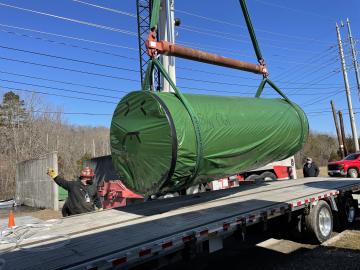Filter News
Area of Research
- (-) Fusion and Fission (32)
- (-) Materials for Computing (13)
- Advanced Manufacturing (5)
- Biological Systems (1)
- Biology and Environment (102)
- Biology and Soft Matter (4)
- Building Technologies (2)
- Chemical and Engineering Materials (3)
- Chemistry and Physics at Interfaces (7)
- Clean Energy (168)
- Climate and Environmental Systems (7)
- Computational Biology (1)
- Computational Chemistry (5)
- Computational Engineering (1)
- Computer Science (3)
- Data (1)
- Earth Sciences (1)
- Electricity and Smart Grid (1)
- Energy Frontier Research Centers (7)
- Fuel Cycle Science and Technology (2)
- Functional Materials for Energy (8)
- Fusion Energy (7)
- Geographic Information Science and Technology (1)
- Isotopes (21)
- Materials (122)
- Materials Synthesis from Atoms to Systems (8)
- Materials Under Extremes (7)
- National Security (45)
- Neutron Data Analysis and Visualization (2)
- Neutron Science (72)
- Nuclear Science and Technology (27)
- Quantum Condensed Matter (3)
- Quantum information Science (4)
- Renewable Energy (2)
- Sensors and Controls (2)
- Supercomputing (153)
- Transportation Systems (4)
News Topics
- 3-D Printing/Advanced Manufacturing (3)
- Advanced Reactors (2)
- Artificial Intelligence (1)
- Bioenergy (2)
- Biology (1)
- Buildings (1)
- Chemical Sciences (3)
- Climate Change (1)
- Composites (1)
- Computer Science (5)
- Coronavirus (1)
- Decarbonization (2)
- Energy Storage (4)
- Environment (2)
- Exascale Computing (1)
- Frontier (1)
- Fusion (12)
- Grid (1)
- High-Performance Computing (2)
- ITER (2)
- Materials (2)
- Materials Science (4)
- Microscopy (1)
- Nanotechnology (3)
- Net Zero (1)
- Neutron Science (2)
- Nuclear Energy (17)
- Partnerships (1)
- Physics (1)
- Polymers (1)
- Quantum Computing (1)
- Quantum Science (1)
- Security (1)
- Simulation (3)
- Sustainable Energy (4)
- Transportation (3)
Media Contacts

Tackling the climate crisis and achieving an equitable clean energy future are among the biggest challenges of our time.

A study by researchers at the ORNL takes a fresh look at what could become the first step toward a new generation of solar batteries.

ORNL manages the Innovation Network for Fusion Energy Program, or INFUSE, with Princeton Plasma Physics Laboratory, to help the private sector find solutions to technical challenges that need to be resolved to make practical fusion energy a reality.

A team led by the U.S. Department of Energy’s Oak Ridge National Laboratory demonstrated the viability of a “quantum entanglement witness” capable of proving the presence of entanglement between magnetic particles, or spins, in a quantum material.

The receipt of a nuclear fuel canister is boosting the research of an Oak Ridge National Laboratory team investigating methods to help the nation effectively dispose of nuclear waste for the long term.

Four first-of-a-kind 3D-printed fuel assembly brackets, produced at the Department of Energy’s Manufacturing Demonstration Facility at Oak Ridge National Laboratory, have been installed and are now under routine operating

Oak Ridge National Laboratory expertise in fission and fusion has come together to form a new collaboration, the Fusion Energy Reactor Models Integrator, or FERMI

Through a consortium of Department of Energy national laboratories, ORNL scientists are applying their expertise to provide solutions that enable the commercialization of emission-free hydrogen fuel cell technology for heavy-duty

Toward the goal of bringing the next generation of nuclear power reactor technology online this decade, ORNL and Analysis and Measurement Services Corporation have successfully completed loop testing of instrument and control sensors for an advanced reactor design for small modular reactors.

When COVID-19 was declared a pandemic in March 2020, Oak Ridge National Laboratory’s Parans Paranthaman suddenly found himself working from home like millions of others.




